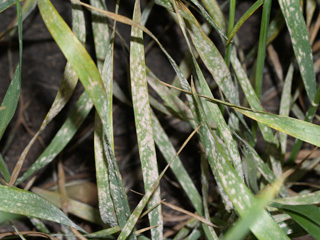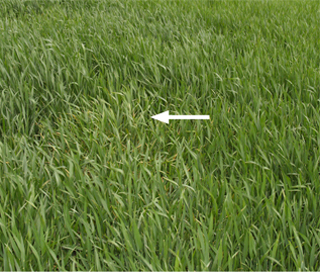G1997
Powdery Mildew of Wheat
This guide explores how to recognize and manage powdery mildew of wheat.
Stephen N. Wegulo, Extension Plant Pathologist
- Cause and Occurrence
- Disease Symptoms
- Disease Cycle
- Favorable Conditions
- Cultural Management
- Management by Fungicide Application
- Acknowledgment
|
Cause and Occurrence
Powdery mildew of wheat is caused by the fungus Blumeria graminis f. sp. tritici. In Nebraska, the disease usually occurs from May to July, but can also occur on newly emerged wheat in the fall. It’s more common and severe in irrigated fields and in the south central and eastern parts of the state where environmental conditions favor its development.
Disease Symptoms
Powdery mildew is characterized by white, cottony patches (colonies) of mycelium and conidia (asexual spores) on the surface of the plant. They can occur on all aerial parts of the plant including stems (Figure 1) and heads, but are most conspicuous on the upper surfaces of lower leaves (Figure 2). The white colonies later turn dull gray-brown. Severe infections can cause stunting (Figure 3). Heads on the later, shorter tillers can become heavily diseased because they remain lower in the wheat canopy where humidity is high. As the growing season progresses, sexual fruiting structures known as cleistothecia appear as distinct brown-black dots within aging colonies on maturing plants. When severe, individual patches often merge and cover large areas of the stem, leaf surface, or head. Leaf tissue on the opposite side of the mildew pustules becomes yellow, later turning tan or brown.
Disease Cycle
The powdery mildew fungus overwinters on straw as cleistothecia. If the winter is mild, it can also overwinter as mycelium and conidia.
Initial infections in the spring are caused by windborne conidia or ascospores (sexual spores released from cleistothecia). Conidia, the major cause of powdery mildew infections, are produced in large numbers from initial infections. Spread by wind, they land on the plant surface, germinate, and cause new infections on healthy plants or secondary infections on already infected plants.
Favorable Conditions
Germination of conidia:
- does not require free moisture
- occurs over a wide temperature range (34° to 86°F); and
- is optimal at 100 percent relative humidity (RH) but can occur at 85 percent RH.
Disease development is optimal between 59° and 72°F and is significantly reduced above 77°F. Prolonged cloudy weather favors disease development. Under conditions of high RH and moderate to warm temperatures, the latent period (the time from infection to sporulation) is 7 to 10 days. Powdery mildew is also favored by overfertilization with nitrogen, lush growth, a dense canopy, and susceptible cultivars. Epidemics tend to occur when warm weather alternates with dry and wet periods, accompanied by wind.
Cultural Management
In most years powdery mildew will not be a yield-limiting disease in Nebraska, despite the potential for sporadic, widespread, and moderately severe outbreaks. Dense stands of heavily fertilized, irrigated wheat are most prone to mildew.
In Nebraska, some of the better-yielding and more popular wheat cultivars are susceptible to powdery mildew. Therefore, growing mildew-resistant cultivars is an option, but rust resistance (especially stem rust) must be the top priority in selecting disease-resistant cultivars.
Use a balanced fertility program based on soil-test analysis. Heavy nitrogen applications and high seeding rates produce dense canopies that favor mildew development. Infrequent, heavier irrigations will be more successful than more frequent, lighter irrigations.
Management by Fungicide Application
Applying foliar fungicides (Table I) can help control powdery mildew. Scout fields for mildew, rust and other leaf diseases, and assess incidence and severity from tiller elongation through flowering.
It’s important to keep disease levels on the top two leaves (flag and flag-1 leaves) and the head to a minimum to prolong the grain filling period. Base your decision whether to apply a fungicide on the:
- level of disease present;
- susceptibility of the cultivar;
- plant’s stage of development;
- weather forecasts favorable to disease development;
- potential yield; and
- current selling price of the grain.
Fungicide application should be timed to protect the flag leaf. If disease is widespread in the field, there is moderate to heavy infection in the lower canopy (Figures 1 and 2), and disease is progressing up the plant, consider applying a fungicide to protect the flag leaf.
| Table I. Fungicides registered for foliar diseases of wheat1. | ||||||||
Fungicide
Trade Name2 |
Active
Ingredient |
Fungicide
Class |
Rate/Acre |
Application |
Re-entry
Interval (REI) |
Pre-Harvest
Interval (PHI) for Grain |
||
Aerial |
Chemigation |
Ground |
||||||
| Bumper® | propiconazole | triazole | 4 fl oz | 2 gpa3 minimum | Not allowed | 10 gpa minimum recommended | 24 hours | 40 days before harvest |
| Caramba™ | metconazole | triazole | 10-17 fl oz | 2 gpa minimum | Not allowed | Adequate for coverage and canopy penetration | 12 hours | 30 days before harvest |
| Folicur® | tebuconazole | triazole | 4 fl oz | 5 gpa minimum | Not allowed | 10 gpa minimum | 12 hours | 30 days before harvest |
| Headline® | pyraclostrobin | strobilurin | 6-9 fl oz | 2 gpa minimum | Allowed, <0.5” app. | Adequate for coverage and canopy penetration | 12 hours | Apply no later than Feekes 10.5 |
| Muscle™ | tebuconazole | triazole | 4 fl oz | 5 gpa minimum | Not allowed | 10 gpa minimum | 12 hours | 30 days before harvest |
| Orius® | tebuconazole | triazole | 4 fl oz | 5 gpa minimum | Not allowed | 10 gpa minimum | 12 hours | 30 days before harvest |
| Proline™ | prothioconazole | triazole | 4.3-5.7 fl oz | 5 gpa minimum | Not allowed | 10 gpa minimum | 12 hours | 30 days before harvest |
| PropiMax | propiconazole | triazole | 2-4 fl oz | 5 gpa minimum | Allowed, <0.1-0.25” app. | 15 gpa minimum | 24 hours | 40 days before harvest |
| Prosaro™ | prothioconazole + tebuconazole | triazole + triazole | 6.5-8.2 fl oz | 5 gpa minimum | Not allowed | 10 gpa minimum | 12 hours | 30 days before harvest |
| Quadris® | azoxystrobin | strobilurin | 4-12 fl oz | 5 gpa minimum | Allowed, <0.5” app. | 10 gpa minimum | 4 hours | Apply no later than Feekes 10.5 |
| Quilt™ | propiconazole + azoxystrobin | triazole + strobilurin | 10.5-14 fl oz | 2 gpa minimum | Allowed, <0.1-0.25” app. | 10 gpa minimum (15 gpa recommended) | 12 hours | Apply no later than Feekes 10.5 |
| Stratego® | propiconazole + trifloxystrobin | triazole + strobilurin | 10 fl oz | 5 gpa minimum | Allowed, <0.5” app. | 10 gpa minimum recommended | 12 hours | Apply no later than Feekes 10.5 |
| Tebuzol™ | tebuconazole | triazole | 4 fl oz | 5 gpa minimum | Allowed, <0.5” app. | 10 gpa minimum | 12 hours | 30 days before harvest |
| Tilt® | propiconazole | triazole | 2-4 fl oz | 2 gpa minimum | Not allowed | 10 gpa minimum | 12 hours | 40 days before harvest |
| Toledo® | tebuconazole | triazole | 4 fl oz | 5 gpa minimum | Allowed, <0.5” app. | 10 gpa minimum | 12 hours | 30 days before harvest |
| Twinline™ | metconazole + pyraclostribin | triazole + strobilurin | 7-9 fl oz | 2 gpa minimum | Allowed, <0.5” app. | Adequate for coverage and canopy penetration | 12 hours | Apply no later then Feekes 10.5 |
| 1Read the label to ensure the fungicide has activity against the target diseases. 2Fungicides listed represent the best information available. 3gpa = gallons per acre. |
||||||||
Acknowledgment
The author would like to thank John E. Watkins, extension plant pathologist and author of the original version of this NebGuide.
This publication has been peer reviewed.
Disclaimer Reference to commercial products or trade names is made with the understanding that no discrimination is intended of those not mentioned and no endorsement by University of Nebraska–Lincoln Extension is implied for those mentioned. |
Visit the University of Nebraska–Lincoln Extension Publications Web site for more publications.
Index: Plant Diseases
Field Crops
Issued February 2010


